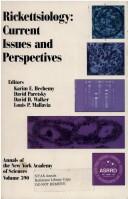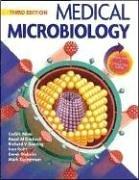| Listing 1 - 10 of 51 | << page >> |
Sort by
|

ISBN: 0897665910 0897665929 Year: 1990 Volume: 590
Abstract | Keywords | Export | Availability | Bookmark
 Loading...
Loading...Choose an application
- Reference Manager
- EndNote
- RefWorks (Direct export to RefWorks)
Rickettsial diseases --- Physiology [Pathological ] --- Congresses --- Epidemiology --- Rickettsia --- Pathogenicity --- Rickettsiaceae infections
Book
ISBN: 9781107668188 1107668182 9781316179390 9781139002967 Year: 2012 Publisher: Cambridge: Cambridge university press,
Abstract | Keywords | Export | Availability | Bookmark
 Loading...
Loading...Choose an application
- Reference Manager
- EndNote
- RefWorks (Direct export to RefWorks)
Despite numerous scientific investigations on vector-borne human infections such as malaria, filariasis, Lyme disease and typhus, these diseases continue to threaten human health. Understanding the role of vectors in disease transmission, and the most appropriate control strategies, is therefore essential. This book provides information on the recognition, biology, ecology and medical importance of the arthropods that affect human health. The fifth edition of this popular textbook is completely updated, and incorporates the latest strategies for controlling insects, ticks and mites. Numerous illustrations, with new colour photographs of some of the most important vectors, aid recognition. A glossary of entomological and epidemiological terms is included, along with a list of commonly used insecticides and their trade names. Clearly presented in a concise style, this text is aimed at students of medical entomology, tropical medicine, parasitology and pest control. It is also essential reading for physicians, health officials and community health workers.
Insects --- Arachnid Vectors. --- Arachnida --- Communicable Diseases --- Insect Vectors. --- Entomology. --- Insects as carriers of disease. --- Insectes (Vecteurs de maladies) --- Entomologie --- pathogenicity. --- transmission. --- Arachnid Vectors --- Insect Vectors --- pathogenicity --- transmission --- Insecta --- Insects - pathogenicity --- Arachnida - pathogenicity --- Communicable Diseases - transmission
Multi
ISBN: 9780128206171 0128206179 9780128206027 0128206020 Year: 2020 Publisher: London, England : Academic Press,
Abstract | Keywords | Export | Availability | Bookmark
 Loading...
Loading...Choose an application
- Reference Manager
- EndNote
- RefWorks (Direct export to RefWorks)
The Developing Microbiome: Lessons from Early Life focuses on the establishment of the microbiome in early life, exposing it as a key mediator of diseases and health throughout the lifecycle. The content presents a comprehensive view of the status of the field and draws real-world correlations to health and disease states. It collates the significant research being done in the pediatric microbiome research space and bridges the knowledge gap showing the factors that impact health and disease states throughout the lifecycle. Finally, it offers knowledge on how the microbiome is and can be manipulated to promote change. This is a perfect reference for both researchers and clinical scientists who are interested in the role of the infant microbiome in health and disease, as well as gastroenterologists and pediatricians looking to affect change in their patients.
Bacteria --- Pathogenic microorganisms. --- Microorganisms. --- Human body --- Molecular microbiology. --- Infants. --- Pediatrics. --- Mothers. --- Medical microbiology. --- Microbiology. --- Bacteria. --- Infant. --- Health aspects. --- pathogenicity --- pathogenicity.

ISBN: 0323035752 0723434034 Year: 2006 Publisher: Edinburgh Elsevier Mosby
Abstract | Keywords | Export | Availability | Bookmark
 Loading...
Loading...Choose an application
- Reference Manager
- EndNote
- RefWorks (Direct export to RefWorks)
Book
ISBN: 9781904455424 1904455425 Year: 2009 Publisher: Caister: Caister,
Abstract | Keywords | Export | Availability | Bookmark
 Loading...
Loading...Choose an application
- Reference Manager
- EndNote
- RefWorks (Direct export to RefWorks)
Pathogenic bacteria --- Proteins --- Secretion --- Pathogenic bacteria. --- Bacteria --- Secretion. --- pathogenicity. --- physiology. --- Proteins - Secretion
Book
ISBN: 0128016930 0128014741 9780128016930 9780128014745 9780128014745 Year: 2016 Publisher: Amsterdam, [Netherlands] : Academic Press,
Abstract | Keywords | Export | Availability | Bookmark
 Loading...
Loading...Choose an application
- Reference Manager
- EndNote
- RefWorks (Direct export to RefWorks)
"The Diverse Faces of Bacillus cereus elucidates salient characteristics of this microorganism, from its environmental and ecologic relevance, to its veterinary involvement and its medical aspects, the latter including several and diverse syndromes such as the most common Bacillus cereus-associated foodborne poisoning and the less frequent airway disease mimicking anthrax. Bacillus cereus has an almost ubiquitary environmental distribution and may cause serious, even fatal, human diseases as well. The bacterium, nevertheless, is also used as a biocontrol agent to face microorganism-related vegetable decay due to its natural antimicrobial properties. Once considered as a mere colonizer or contaminant, in fact, Bacillus cereus is nowadays acquiring increasing importance both as an agent of infections and as an organism of biotechnological and agricultural interest. Also, researchers, clinicians, and students alike will benefit from this clear compendium on the phenotype-based and molecular techniques and procedures that may be adopted or followed to correctly identify this intriguing multi-faceted microorganism."--
Microbiology & Immunology --- Biology --- Health & Biological Sciences --- Bacillus (Bacteria) --- Bacillus cereus. --- Bacillus --- Bacillaceae --- Bacillus cereus --- pathogenicity.

ISBN: 1555813658 9781555813659 9781555815714 1555815715 128303400X 9786613034007 Year: 2006 Publisher: Washington, D.C. : ASM Press,
Abstract | Keywords | Export | Availability | Bookmark
 Loading...
Loading...Choose an application
- Reference Manager
- EndNote
- RefWorks (Direct export to RefWorks)
This new volume presents research on the biology of vibrios, examining the impact of innovative molecular and genomic approaches on the traditional disciplines in the field. It is a valuable reference to bacterial taxonomists, microbial ecologists, health management professionals, researchers, lecturers, and students of marine biology and aquaculture.
Vibrio Infections --- Vibrio infections. --- Vibrio --- Vibrio. --- etiology. --- pathogenicity. --- Gram-negative bacterial infections --- Beneckea --- Vibrionaceae
Book
ISBN: 1555817327 9781555817329 9781555816742 1555816746 1683670612 Year: 2012 Publisher: Washington, D.C. : ASM Press,
Abstract | Keywords | Export | Availability | Bookmark
 Loading...
Loading...Choose an application
- Reference Manager
- EndNote
- RefWorks (Direct export to RefWorks)
Chlamydia infections. --- Chlamydial infections --- Gram-negative bacterial infections --- Chlamydia Infections. --- Chlamydiales --- pathogenicity.
Book
ISBN: 0323852211 0323852068 9780323852210 9780323852067 Year: 2022 Publisher: Duxford, England : Woodhead Publishing,
Abstract | Keywords | Export | Availability | Bookmark
 Loading...
Loading...Choose an application
- Reference Manager
- EndNote
- RefWorks (Direct export to RefWorks)
"Viruses, Bacteria and Fungi in the Built Environment: Designing Healthy Indoor Environments opens with a brief introduction to viruses, bacteria and fungi in the built environment and discusses their impact on human health. Sections discuss the microbiology of building materials, the airborne transmission of viruses and bacteria in the built environment, and plumbing-associated microbiome. [ . . . ] Elements of building design, including choice of materials, ventilation and plumbing can have important implications for the microbiology of a building, and consequently, the health of the building's occupants. This important new reference work explains the microbiology of buildings and disease control in the built environment to those who design and implement new construction and renovate."--
Building materials --- Environmental aspects. --- Indoor air pollution --- Sanitary engineering. --- Air Pollution, Indoor --- Microbiota --- Construction Materials --- Viruses --- Fungi --- Bacteria --- Environmental Health --- Environmental Microbiology --- Microbiology. --- Health aspects. --- microbiology --- pathogenicity --- Air Pollution, Indoor. --- Microbiota. --- Environmental Health. --- Environmental Microbiology. --- microbiology. --- pathogenicity.
Book
ISBN: 0323919480 0323919448 9780323919449 9780323919487 Year: 2022 Publisher: London, England ; San Diego, California : Elsevier,
Abstract | Keywords | Export | Availability | Bookmark
 Loading...
Loading...Choose an application
- Reference Manager
- EndNote
- RefWorks (Direct export to RefWorks)
Biology of Mycobacterial Lipids covers various topics pertaining to the advancements and current research in the field of mycobacterial lipids, and on the significant progress in lipidomics, in recent times. The chapters present comprehensive, yet systematic cutting-edge research, comprising mycobacterial lipid terminologies, classifications, biosynthetic pathways, tools and techniques, and functional burgeoning. This unique reference book has contributions from pioneer researchers, experts, and eminent veterans from around the globe. It covers ground-breaking work that will bridge the gap between understanding biochemical patterns related to virulence, pathogenesis, and resistance and elucidating new targets for drug design, identifying biomarkers for predicting risk, early diagnosis, and therapeutic outcome.
Mycobacteria. --- Mycobacteriaceae --- Actinomycetales --- Microbiology. --- Mycobacterial diseases. --- Mycobacterial disease --- Mycobacterial infections --- Mycobacterioses --- Mycobacterium infections --- Gram-positive bacterial infections --- Microbial biology --- Biology --- Microorganisms --- Microbial lipids. --- Mycobacterium --- Lipids --- Lipid Metabolism --- pathogenicity --- Mycobacterium. --- Lipids. --- Lipid Metabolism. --- pathogenicity.
| Listing 1 - 10 of 51 | << page >> |
Sort by
|

 Search
Search Feedback
Feedback About UniCat
About UniCat  Help
Help News
News